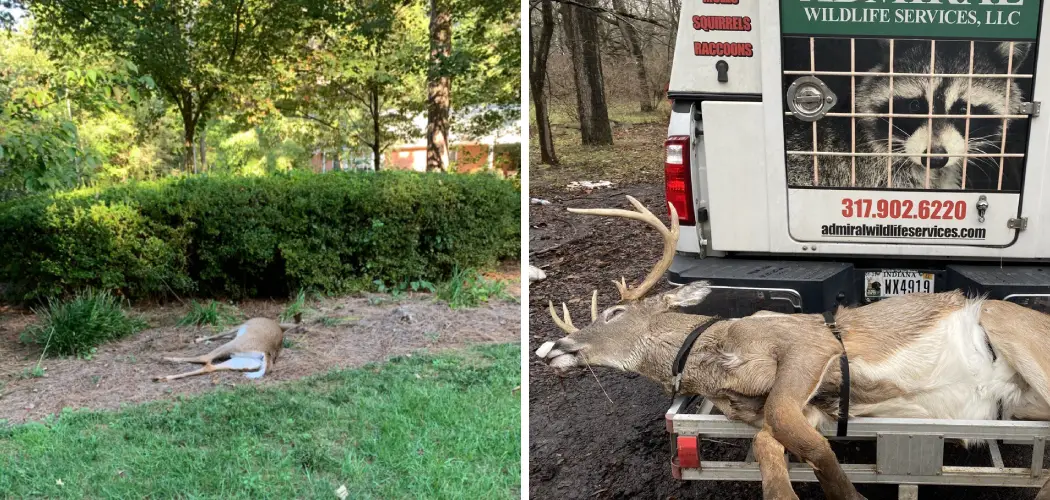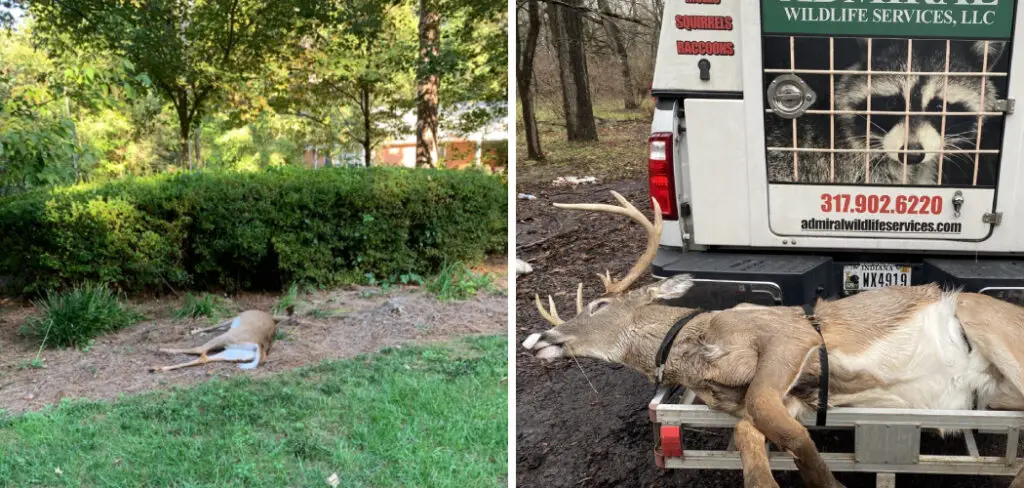
Removing a dead deer from your yard can be an unpleasant task, but it should not be taken lightly. A dead deer, especially in the summer months, can attract pests and spread diseases such as rabies. Removing the deer quickly and safely will help to keep your family safe and healthy. Additionally, depending on local laws and regulations, failure to remove the deer may result in fines or other consequences.
Removing a dead deer from your yard has many advantages. First, it prevents scavengers from visiting your property and possibly damaging the landscaping or eating any other animals you may have on your property. Removing the carcass also removes potential disease transmission risks to you, your family, and any pets that can wander near the carcass.
It also eliminates the unpleasant odor of a decaying carcass. In this blog post, You will learn in detail how to remove a dead deer from your yard.
Tools or Equipment You Will Need
- Disposable gloves
- Protective eyewear
- Disinfectant
- A tarp or sheet of plastic material
- Work boots and rubber boots
- A shovel
- Rope or twine
- Plastic bags for disposal
- Heavy-duty work gloves
- Trash cans with lids for the disposal
Step-by-Step Processes for How to Remove a Dead Deer From Your Yard
Step 1: Inspect the Dead Deer
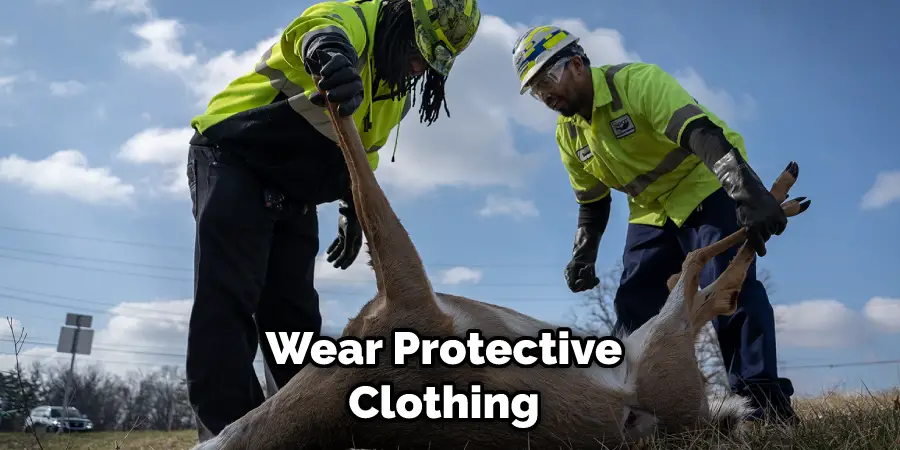
Be sure to check for any signs of life and make sure the deer is truly dead. If you are unsure, contact your local wildlife agency. Wear protective clothing and gloves to avoid coming into contact with any potential contaminants and diseases that may be present in the carcass.
Step 2: Contact Your Local Authorities
Contact your local authorities to determine if you need a permit or assistance with removing the deer. Depending on where you live, there may be regulations in place that must be followed when removing a dead deer from your property. You will need a few supplies to safely and efficiently remove the deer.
Gather a tarp or two for transporting the deer, gloves, garbage bags, and disinfectant. Optional items include a shovel or spade for digging and a cover-up such as an old sheet.
Step 3: Move the Deer
Depending on the size of the deer, you may need to enlist help to move it safely. Place a tarp or two beneath the body and pull it onto the tarps. Cover up with another piece of material if needed. The best way to dispose of a dead deer is to have it incinerated or buried.
If possible, contact your local animal control service for assistance with the removal and disposal of the deer.
Step 4: Clean and Disinfect the Area
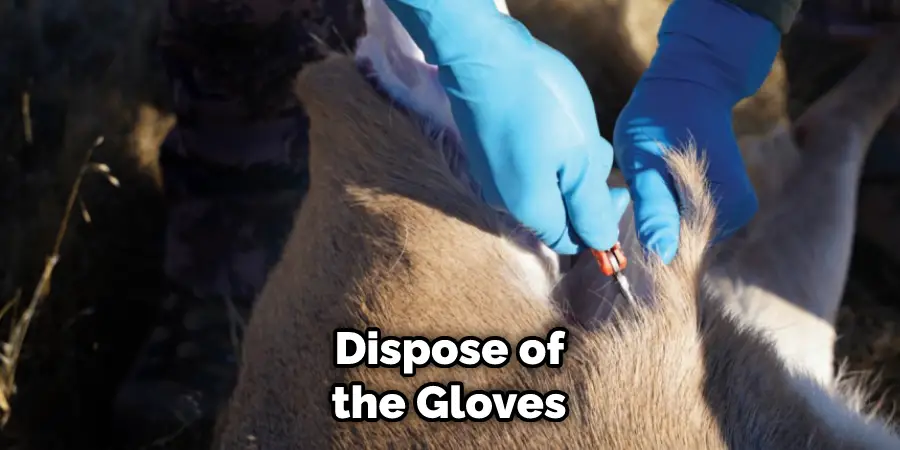
Once you are done moving the deer, spray down any area that was exposed to fluids from the carcass using a disinfectant. Dispose of the gloves, tarps, and other materials you used to move the deer in a sealed plastic bag. If you are burying the animal, make sure to cover it with at least 8 inches of soil.
Place rocks or other heavy objects on top to prevent animals from digging them up.
Step 5: Alert Your Neighbors
Let your neighbors know that you have removed a dead deer from the area and to be aware of any potential health risks associated with coming into contact with the carcass. Depending on where you live, there may be regulations in place regarding the disposal of dead animals.
Contact your local wildlife agency or animal control service if you need assistance or have additional questions.
Step 6: Monitor Your Property
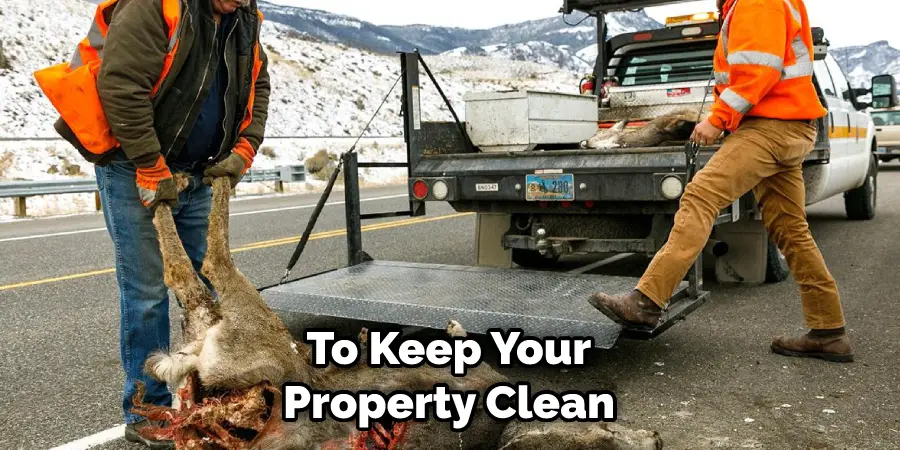
Keep an eye on your property to ensure no other dead animals appear. If you notice any suspicious activity, contact your local authorities immediately. Make sure to keep your property clean and free of any potentially hazardous materials to prevent future incidents.
By following these steps, you can safely and efficiently remove a dead deer from your yard. While it is never enjoyable, it is important to handle the situation properly to avoid potential health risks or legal issues.
Safety Tips for How to Remove a Dead Deer From Your Yard
- Always make sure to wear safety gloves, glasses/goggles, and a breathing mask when handling the deer.
- It is best to have someone else assist you when removing the dead deer due to the size and weight of the animal.
- Use a tarp, shovels, and other tools to move the deer from your yard.
- Depending on where you live, specific regulations are in place for disposing of the dead animal. Check with local authorities for more information about disposal rules in your area.
- Use an approved disinfectant to clean and decontaminate the area where the deer was located.
- Inspect yourself for any cuts or scratches that may have been caused by handling the deer. Seek medical attention if necessary.
- Make sure to keep a close eye on any pets that may have been in the area while you were handling the deer. They could be contaminated with infectious diseases, so make sure to take them to a veterinarian for a checkup if necessary.
Following these safety tips and precautions will ensure that your family, yourself and your yard are safe when removing a dead deer from your yard.
How Can You Protect Yourself From Potential Diseases When Handling a Dead Deer?
- Wear protective clothing and gloves, such as rubber or latex gloves and a face mask.
- Avoid contact with the deer’s body fluids, such as blood, saliva, urine, and feces.
- Dispose of the carcass by double-bagging it in plastic bags or tarpaulin before burying it or having it picked up by a professional.
- Wash your hands with soap and water for at least 20 seconds after handling the carcass or any objects that have come into contact with it.
- Disinfect items such as tools, gloves, and clothing that have been used or come into contact with the deer’s body.
- If you have been in contact with a dead deer, seek medical advice from your doctor, as there is a risk of infection from the deer’s body fluids.
- To reduce the risk of transmission, only handle dead deer with appropriate protective clothing and use tools such as shovels or other long-handled implements.
- Avoid contact with other animals that may have come into contacts with the dead deer, such as scavengers or pets.
- Monitor your health for any unusual symptoms and seek medical advice if necessary.
- Stay up to date on vaccinations to protect yourself from potential diseases from wild animals, including rabies and other zoonotic diseases.
- Disinfect any areas or surfaces with which the deer may have come into contacts, such as outdoor furniture and decks.
- Report the presence of a dead deer to your local health department for further investigation and risk assessment.
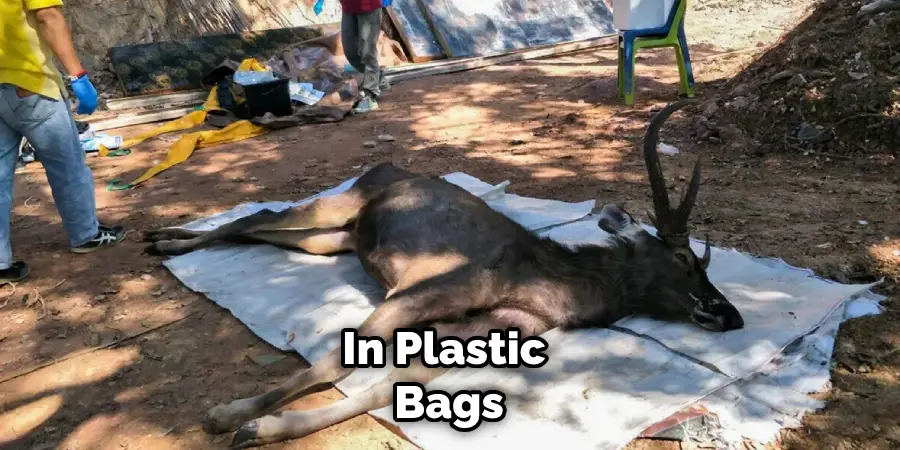
By taking these steps, you can reduce the risks of potential diseases when handling a dead deer from your yard and keep yourself and your family safe.
How Can You Prevent Further Damage or Mess When Trying to Remove a Dead Deer From Your Yard?
Removing a dead deer from your yard can be a difficult, messy, and uncomfortable task. To help prevent further damage and mess, there are some things you should keep in mind before getting started:
- Wear protective gear such as gloves, long sleeves, pants, and boots when handling the deer.
- If the deer is in an area with a lot of vegetation, clear the area of any plants that could be damaged during the removal.
- If possible, cover the deer with a tarp or other protective material to contain any fluids and odors that may occur when handling it.
- Place the deer in a plastic garbage bag for proper disposal once it is removed from your property.
- Dispose of the carcass properly in an authorized landfill or wildlife disposal center, where it can be disposed of safely and without risk of disease transmission.
By following these steps, you can help ensure that there is minimal mess and damage when removing a dead deer from your yard. With proper precautions and planning, you can make the process of removal easier and more efficient.
Conclusion
In conclusion, removing a dead deer from your yard is not an easy task. It requires a lot of physical effort and proper safety equipment. When removing a dead deer from your yard, the key points to remember are to wear protective clothing, have appropriate tools, dispose of the carcass responsibly, and take safety precautions.
With these steps in mind, you can be sure that the job is done safely and properly. If you need assistance, contact your local wildlife or animal control professionals to assist in removing a dead deer from your yard. I hope reading this post has helped you learn how to remove a dead deer from your yard.
Make sure the safety precautions are carried out in the order listed.
About
Outdoor Fixes is a distinguished figure in the world of Diy design, with a decade of expertise creating innovative and sustainable Diy solutions.
His professional focus lies in merging traditional craftsmanship with modern manufacturing techniques,
fostering designs that are both practical and environmentally conscious. As the author of diy,
outdoorfixes delves into the art and science of outdoorfixes-making, inspiring artisans and industry professionals alike.
Education RMIT University
(Melbourne, Australia) Associate Degree in Design (Outdoor Fixes) Focus on sustainable design, industry-driven projects,
and practical craftsmanship. Gained hands-on experience with traditional and digital manufacturing tools, such as CAD and CNC software.
Nottingham Trent University
(United Kingdom) Bachelor’s in outdoorfixes.com and Product Design (Honors) Specialized in product design with a focus on blending creativity with production
techniques. Participated in industry projects, working with companies like John Lewis and Vitsoe to gain real-world insights.
Publications and Impact
In diy, Outdoor Fixes his insights on indoor design processes, materials, and strategies for efficient production.
His writing bridges the gap between artisan knowledge and modern industry needs, making it a must-read for both budding designers and seasoned professionals.

